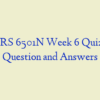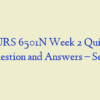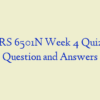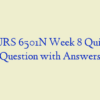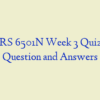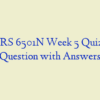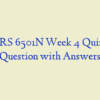Description
NURS 6501 Final Exam 2 – Question and Answers (Spring Term)
- What is the link between major depression and cortisol secretion?
- A patient has chronic anemia associated with chronic renal failure. What substance does the healthcare professional tell the patient is needed to treat this anemia?
- What is the first indication of nephrotic syndrome in children?
- A patient is in the Emergency Department with heatstroke. What finding does the healthcare provider associate with this condition?
- Clinical manifestations that include irregular or heavy bleeding, the passage of large clots, and the depletion of iron stores support which diagnosis?
- The health care professional is caring for a person who has a pathologic fracture. The patient asks the professional to explain the condition. What response by the professional is best?
- A patient has a temporary displacement of two bones in a joint causing the bone surfaces to partially lose contact with each other. What treatment does the health care professional prepare the patient for?
- Cystic fibrosis is characterized by which symptom?
- An infant has gluten-sensitive enteropathy and the parents ask the healthcare professional to explain why the baby bruises so easily. The professional explains that the baby has which deficit?
- A healthcare professional advises a pregnant woman to add supplements of which nutrient to her diet to prevent birth defects?
- A mother reports that her young teens have voracious appetites. The healthcare professional would explain which hormone is linked to an increase in appetite during puberty?
- Why is nasal congestion a serious threat to young infants?
- A student studying osteomyelitis and asks for an explanation of the term sequestrum. What response by the professor is best?
- Which statement by the healthcare professional accurately describes childhood asthma?
- A patient has a spinal cord injury at C4. What should the healthcare professional assess as the priority in this patient?
- Which cells function to maintain bone matrix?
- To quickly assess a patient’s nervous system for dysfunction, what assessment should the healthcare professional perform as the priority?
- What is the effect of low plasma albumin?
- Which immunoglobulin (Ig) is present in childhood asthma?
- Which mother does the healthcare professional prepare to administer Rh immune globulin (Rho-GAM) to?
- A parent brings a 10-year-old child to the clinic and reports a mottled appearance to the skin and legs cramps when the child is in physical education class. Physical assessment is positive for upper extremity hypertension.
- What diagnostic testing or treatment does the healthcare professional prepare the family for?
- In order to help prevent a preadolescent girl from developing later cervical cancer, which virus does the healthcare professional recommend vaccination against to the parent?
- Which pain theory proposes that a balance of impulses conducted from the spinal cord to the higher centers in the central nervous system (CNS) modulates the transmission of pain?
- A newborn baby displays jaundice 20 hours after birth. What action by the healthcare professional is most appropriate?
- What causes the vasomotor flushes (hot flashes) that are associated with declining ovarian function with age?
- In acute hypothermia, what physiologic change shunts blood away from the colder skin to the body core in an effort to decrease heat loss?
- How does the epididymis become infected?
- What are the clinical manifestations of testicular cancer?
- A healthcare professional is discussing breastfeeding with a pregnant woman. Which beneficial substance does the professional tell the mother is found in breast milk?
- The disruption in cellular adhesion observed in bullous impetigo is caused by an exfoliative toxin related to which organism?
- A patient has been exposed to prolonged high environmental temperatures and now shows signs of dehydration, decreased plasma volumes, hypotension, decreased cardiac output, and tachycardia. What treatment does the healthcare professional prepare to administer to this patient?
- A woman who is positive for hepatitis B is in labor. What action by the healthcare professional is most appropriate?
- A healthcare professional is planning a community event to reduce risk of cerebrovascular accident (CVA) in high risk groups. Which group would the professional target as the priority?
- A pregnant woman is seen for the first time at 6 months’ gestation and has not taken prenatal vitamins. The healthcare professional educates the woman on the need for a blood test specifically to assess what substance?
- A healthcare professional is seeing a patient with suspected schizophrenia. For which prenatal occurrence should the professional assess?
- What congenital malformation is commonly linked to acute leukemia in children?
- Parents bring their 1-year-old child to the emergency department, reporting that the child has been irritable and pounding on her head, has projectile vomiting, and seems very sleepy for most of the last 3 days. What diagnostic testing does the healthcare professional prepare the child and parents for as the priority?
- A patient in the hospital has been receiving heparin injections. The platelet count on admission was 222,000/mm 3 and four days later is 113,000/mm 3. What action by the healthcare professional is best?
- A healthcare professional works with recent refugees. A mother brings in her children who have been diagnosed with iron deficiency anemia. What action by the professional is most appropriate?
- Which patient finding would lead the health care professional to assess the patient for inflammatory joint disease?
- A student asks the professor what the most common pathophysiologic process is that triggers aplastic anemia (AA). What response by the professor is most accurate?
- A student is learning about the pelvic inflammatory disease (PID).
- What information does the student clarify with a study partner as being correct?
- A patient in the healthcare clinic reports fatigue, weakness, and dyspnea, as well as pale conjunctiva of the eyes and brittle, concave nails. What assessment by the healthcare professional is most appropriate for the suspected anemia?
- A patient is 8 hours postoperative after a long orthopedic procedure. The student asks why this patient is at particular risk of developing thromboembolism. What response by the healthcare professional is best?
- A healthcare professional suspects a patient is brain dead. How would the professional assess for brain death?
- An adult patient has been hospitalizing with thrombocytopenia with a platelet count of 8000/mm 3. What action by the healthcare professional is most appropriate?
- A child with acute post-streptococcal glomerulonephritis is voiding smoky, brown-color urine and asks the healthcare professional to explain what causes it. What explanation by the professional is best?
- A patient has pernicious anemia and asks the healthcare professional to explain the disease. Which statement by the professional is most accurate?
- In immunoglobulin G (IgG) nephropathies such as glomerulonephritis, IgG is deposited in which location?
- A child has iron-deficiency anemia. In addition to iron supplements, what else does the healthcare professional educate the parents on giving the child?
- When are childhood cancers most often diagnose?
- Without prior exposure to an antigen, which cells are able to destroy some types of tumor cells and some virus-infected cells?
- A patient has hepatomegaly, bronze-colored skin, and cardiac dysrhythmias. What condition does the healthcare professional prepare to teach the patient about?
- How should the healthcare professional reply when parents question why a computed tomographic (CT) scan of the head was not ordered for their 5-year-old child after a minor fall?
- A healthcare professional is trying to lower a patient’s body temperature by convection. What action by the professional will accomplish this?
- A patient has primary immune thrombocytopenic purpura (ITP) and is hospitalized after a bleeding episode. What treatment does the healthcare provider anticipate being ordered for this patient?
- A student reads in a chart that a child has been diagnosed with mixed precocious puberty and asks for an explanation. What explanation by the healthcare professional is most accurate?
- A woman attempting to conceive tells the healthcare professional that she and her partner have intercourse when her basal body temperature (BBT) is around 37?C (98?F) without getting pregnant. What information does the professional give the woman?
- A student reads in a chart that a baby was born with an encephalocele. The student asks the healthcare professional to explain this condition. What explanation by the healthcare professional is best?
- A student asks the healthcare professional why researchers are trying to link specific genes to specific asthma phenotypes. What response by the professional is best?
- A health care professional is teaching a group of college women about increasing calcium in the diet to prevent osteoporosis.
- A participant asks at what age is peak bone mass is reached in women. What response is best?
- The student wants to know how the clinical manifestations and onset of juvenile idiopathic arthritis (JIA) differ from those of rheumatoid arthritis (RA) in adults. What answer by the healthcare professional is best?
- A child has Duchenne muscular dystrophy. What complication does the healthcare professional teach the parents is most important to control?
- A 9-year-old child has a blood pressure of 112/72 mmHg in the school nurse’s office. What action by the school nurse is most appropriate?
- An infant is brought to the emergency department by parents who report that the baby’s fontanels seem to be bulging outward. What action by the healthcare provider is most appropriate?
- What diagnosis is give to parents when their infant’s hip maintains contact with the acetabulum but is not well seated within the hip joint?
- The student asks the professor for a definition of orexigenic neurons. What description by the professor is most accurate?
- A patient is in the intensive care unit and has intracranial pressure (ICP) monitoring. The patient’s ICP is 17 mmHg. The healthcare professional notes that the chart indicates the patient is now in stage 1 intracranial hypertension. What assessment finding does the professional association with this condition?
- A preschool teacher notices a child who has burrows on the hands that are several millimeters to 1 cm long, papules, and vesicular lesions. What other assessment finding would help the teacher determine the type of infestation the child has?
- A man has balanitis. What action by the healthcare professional is most appropriate?
- Which condition is consistent with the cardiac defect of transposition of the great vessels?
- A newborn has meconium ileus. What diagnostic test does the healthcare professional advise the parents about?
- Which condition is consider a clinical cause of amenorrhea?
- The healthcare professional directs a student to assess a teen who has Osgood-Schlatter disease. What assessment finding does the student anticipate for this disorder?
- A healthcare professional is educating a community men’s group on symptoms of benign prostatic hyperplasia (BPH). The professional relates that most symptoms are a result of which pathophysiologic condition?
- A patient has been diagnose with acute lymphocytic leukemia (ALL) and asks the healthcare professional to describe it. What description by the professional is most accurate?
- A child has cystic fibrosis (CF). Which medication does the healthcare professional teach the parents about?
- A woman diagnoses with trichomoniasis asks if her sexual partner should be treat as well. What is the appropriate response by the healthcare professional?
- A healthcare professional is caring for a patient diagnosed with aphasia. What action by the professional would be best in working with this patient?
- In which stage of syphilis would the following clinical manifestations be found: destructive skin, bone and soft tissue lesions, aneurysms, heart failure, and neurosyphilis?
- What is the most abundant class of plasma protein?
- A baby is born with myelomeningocele and needs urgent surgery to repair the defect. The parents want to take the baby home instead. What does the healthcare professional tell the parents about the purpose of this surgery?
- A student asks the health care professional why obese people are at higher risk for hypertension than non-obese individuals. What response by the professional is best?
- In the majority of children experiencing delayed puberty, what is the problem caused by?
- A patient has been diagnose with lithium toxicity. Which electrolyte imbalance does the healthcare professional correlate with this condition?
- A healthcare professional has educated a student on folic acid. Which statement by the student indicates that more teaching is needed?
- A patient had a seizure that consisted of impaired consciousness and the appearance of a dreamlike state. How does the healthcare professional chart this episode?
- A health care professional is caring for a patient admit to the hospital with severe anorexia. What action by the health care professional would be most important?
- Parents report their 3-week-old infant who eats well and has gained weight began to have projectile vomiting for no apparent reason. What treatment option does the healthcare professional prepare to educate the parents on?
- Prenatal exposure to diethylstilbestrol (DES) can result in which type of cancer?
- An infant has been diagnosed with intussusception and the student asks the healthcare professional to explain the condition. What explanation by the professional is most accurate?
- Local signs and symptoms of Hodgkin disease-related lymphadenopathy are a result of what?
- A woman has been diagnosed with polycystic ovary syndrome but is confuse because her pelvic ultrasound (US) was read as normal and did not show cysts. What response by the health care professional is most appropriate?
- A healthcare professional wants to volunteer for a community education project to help prevent spinal cord injury. What activity would the professional most likely volunteer for?
- A person has abnormally severe tooth decay and erosion of the tooth enamel. What problem should the health care professional assess the person for?
- What is the consequence of a splenectomy?
- A patient is admit to the hospital with multiple myeloma (MM). Which diagnostic test should the healthcare professional assess as the priority?
- A patient has been hospitalize with Guillain-Barré syndrome (GBS). The patient asks how this could have occurred. What response by the healthcare professional is best?
- A parent asks the healthcare professional to explain why a child diagnosed with Tetralogy of Fallot squats frequently. What explanation by the professional is best?
- A patient is in status epilepticus. In addition to giving medication to stop the seizures, what would the healthcare professional place the highest priority on?
- Check out our latest courses


